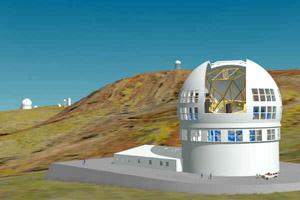| The ING Newsletter | No. 1, September 1999 |
| GENERAL | SCIENCE | TELESCOPES AND INSTRUMENTATION | TELESCOPE TIME |
Previous: Instrumentation Plans for the ING Telescopes | Up: Table of Contents | Next: News from the Computing Facilities Group
ING and GranTeCan
René
Rutten (Director ING)
Within the
next few months groundwork will commence in preparation for a new telescope
that will become the centrepiece of the facilities at the observatory on
La Palma. The new facility under construction is the Gran Telescopio
de Canarias, also known as GranTeCan, or simply GTC. This Spanish
telescope project will have a profound impact on the observatory on La
Palma. Following from an invitation for international partners to
join the project, ING has been exploring ways in which the UK and NL astronomical
communities could become a partner in this exciting large telescope project.
 |
Artist's impression of GranTeCan on the Roque de Los Muchachos Observatory. [ JPEG ] |
GTC is a segmented 10-m aperture telescope based on the Keck telescope design. The project if fully funded by the Spanish Government and by the Canarian Government, including EU money. The project is well under way and various key contracts have now been let. Completion of the telescope is planned for 2003. The GTC project office is based in Tenerife, close to the Instituto de Astrofísica de Canarias, and employs over 30 staff (for more information see http://www.gtc.iac.es/).
The science drivers for GTC are diverse, and for that reason the telescope is designed to be a general-purpose work horse facility. In particular image quality, optimisation for operating wavelengths between 0.3 and 2.5 microns, and operational efficiency are key elements of the telescope design. A set of three 'day-one' instruments has been approved to proceed to preliminary design stage. These instruments are an IR imaging spectrograph (Canari-Cam), a multi-object IR spectrograph (Emir), and an optical imager and spectrograph (Osiris). The selection of these instruments is primarily based on the scientific priorities in the Spanish community, but the interest from in particular UK scientists is reflected in the participation of astronomers in the UK in the definition of these instruments.
The advent of GTC is expected to dominate the scientific work on La Palma in general, and impact on the work carried out at ING. There will be a logical need to co-ordinate science programmes, and very likely scientific collaboration between Spain, the UK and the Netherlands will become stronger once GTC enters into operation. There is an opportunity now to guarantee access for the UK and NL to GTC by formalising the collaboration between the countries currently participating in ING. This opportunity is being explored.
Support from the UK astronomical community for collaboration in the GTC telescope project was highlighted by the broad support which enjoyed the proposal for the UK to join GTC through the 'JIF' opportunity last year. Although this request was unfortunately not successful, it did underline the fact that there is a strong need for more access to large ground-based telescopes. This has also been reflected in PPARC's strategy framework that identifies the lack of access to large telescopes as a serious gap. GTC has the potential to fill this need, at least in the Northern hemisphere. Priorities for the Dutch community have logically been focussed on exploitation of the ESO-VLT as the main ground-based optical-IR facility. Therefore the urgency for the Netherlands to obtain access to more 8-m class telescopes may not be so great, although GTC will provide Dutch astronomers with guaranteed telescope time in the north.
Last year Spain opened the possibility for external partners to join GTC by offering up to 30% of the project to potential partners. This announcement prompted the UK and the NL to jointly pursue the possibility of setting up a partnership between ING and GTC through which the UK/NL would contribute of the order of 10% of the project cost and would obtain an equivalent share of the observing time. The baseline funding for this participation would have to come out of the existing ING budget. Clearly this would have an important impact on the support and development of the existing ING telescopes, but it was felt that this opportunity should not be missed. At the basis of a collaboration with GTC would be a partnership in the operation and development of the telescopes. Efficiency saving at ING through an appropriate base at sea level, a more focussed deployment of instruments, some reduction of support services, and a reduction in the development budget would be inevitable. However, even with these savings the WHT would be able to continue to deliver front-ranked science and still have a significant development budget. Clearly any collaboration with GTC through ING must not undermine the long-term future for the WHT.
A possible collaboration between ING and GTC would not only be very attractive from the scientific perspective, but is also of strategic importance for the long-term future and stability of ING into the era of 8-m class telescopes. Detailed negotiations are still at an early stage, but I am hopeful that a collaboration will emerge and I am looking forward to establish close ties with GTC scientists, engineers, and management.
Email contact: René Rutten (rgmr@ing.iac.es)
Previous: Instrumentation Plans for the ING Telescopes | Up: Table of Contents | Next: News from the Computing Facilities Group
| GENERAL | SCIENCE | TELESCOPES AND INSTRUMENTATION | TELESCOPE TIME |